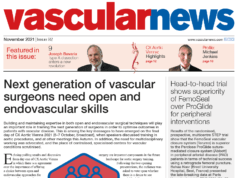
Results of a poll conducted at CX Aortic Vienna 2021 (5–7 October, broadcast) indicated that open procedures have their place in treating the hostile anatomy of the aortic arch, with 100% of voters expressing the opinion that the open elephant trunk technique should still be taught. This followed a series of presentations and edited cases on the frozen elephant trunk (FET) technique.
All sessions are available to view on demand. Click here to register and access the recordings.
Michael Jacobs (Maastricht, The Netherlands) opened the session with an edited case demonstrating the open surgical extension of a frozen elephant trunk (FET) in the aortic arch and thoracoabdominal aneurysm. He concluded that FET makes proximal anastomosis easier in open repair and also that the thoracoabdominal aortic aneurysm (TAAA) procedure is similar to the standard operation without a FET. Jacobs also summarised the findings of his team’s research: “We faced perioperative mortality, however the long-term outcomes are very favourable”.
Registrants can view Jacobs’ edited case on demand here.
A multidisciplinary approach is key to improving results and planning patient-tailored solutions. This was the main conclusion of Luca Bertoglio (Milan, Italy), who presented perioperative and midterm outcomes of open or endovascular treatment of downstream thoracic or thoracoabdominal aortic pathology after FET. He summarised that FET is an optimal solution when any kind of distal thoracic procedures are planned, and that different distal open and endovascular solutions are available.
Registrants can view Bertoglio’s presentation on demand here.

Michael Andrew Borger (Leipzig, Germany) argued that the elephant trunk remains a vital procedure today, highlighting the benefits of open cardiac surgery in the complex anatomy of the aortic arch. “Aortic arch surgery has a long history in cardiac surgery,” he communicated, noting that results are “very good” and have been improving in recent years. In addition, Borger outlined data showing some of the limitations of endovascular therapy. “Although we have made great strides in approaches to the thoracic aorta, there are of course still complications,” he informed the audience.
Borger also detailed that the ascending aorta and aortic arch is “hostile territory” for endovascular therapy due to the angulation and also the extreme mobility of this portion of the aorta. In fact, he noted that “it is much more mobile than any other portion of the aorta”.
“I hope that I have convinced you that conventional elephant trunk surgery is still required today,” Borger said, ending his presentation.
Registrants can view Borger’s presentation on demand here.
In a later presentation, Heinz Jakob (Essen, Germany) described an optimised coagulation regimen in contemporary FET surgery, concluding that it is mandatory to have a modern approach to patient blood management in order to reduce the important risk factor of bleeding and, therefore, improve acute and long-term survival.
Registrants can view Jakob’s presentation on demand here.












